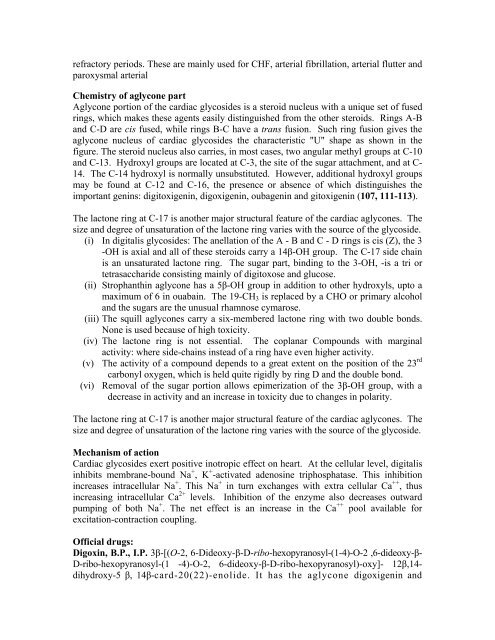MEDICINAL CHEMISTRY
MEDICINAL CHEMISTRY
MEDICINAL CHEMISTRY
Create successful ePaper yourself
Turn your PDF publications into a flip-book with our unique Google optimized e-Paper software.
efractory periods. These are mainly used for CHF, arterial fibrillation, arterial flutter and<br />
paroxysmal arterial<br />
Chemistry of aglycone part<br />
Aglycone portion of the cardiac glycosides is a steroid nucleus with a unique set of fused<br />
rings, which makes these agents easily distinguished from the other steroids. Rings A-B<br />
and C-D are cis fused, while rings B-C have a trans fusion. Such ring fusion gives the<br />
aglycone nucleus of cardiac glycosides the characteristic "U" shape as shown in the<br />
figure. The steroid nucleus also carries, in most cases, two angular methyl groups at C-10<br />
and C-13. Hydroxyl groups are located at C-3, the site of the sugar attachment, and at C-<br />
14. The C-14 hydroxyl is normally unsubstituted. However, additional hydroxyl groups<br />
may be found at C-12 and C-16, the presence or absence of which distinguishes the<br />
important genins: digitoxigenin, digoxigenin, oubagenin and gitoxigenin (107, 111-113).<br />
The lactone ring at C-17 is another major structural feature of the cardiac aglycones. The<br />
size and degree of unsaturation of the lactone ring varies with the source of the glycoside.<br />
(i) In digitalis glycosides: The anellation of the A - B and C - D rings is cis (Z), the 3<br />
-OH is axial and all of these steroids carry a 14β-OH group. The C-17 side chain<br />
is an unsaturated lactone ring. The sugar part, binding to the 3-OH, -is a tri or<br />
tetrasaccharide consisting mainly of digitoxose and glucose.<br />
(ii) Strophanthin aglycone has a 5β-OH group in addition to other hydroxyls, upto a<br />
maximum of 6 in ouabain. The 19-CH3 is replaced by a CHO or primary alcohol<br />
and the sugars are the unusual rhamnose cymarose.<br />
(iii) The squill aglycones carry a six-membered lactone ring with two double bonds.<br />
None is used because of high toxicity.<br />
(iv) The lactone ring is not essential. The coplanar Compounds with marginal<br />
activity: where side-chains instead of a ring have even higher activity.<br />
(v) The activity of a compound depends to a great extent on the position of the 23 rd<br />
carbonyl oxygen, which is held quite rigidly by ring D and the double bond.<br />
(vi) Removal of the sugar portion allows epimerization of the 3β-OH group, with a<br />
decrease in activity and an increase in toxicity due to changes in polarity.<br />
The lactone ring at C-17 is another major structural feature of the cardiac aglycones. The<br />
size and degree of unsaturation of the lactone ring varies with the source of the glycoside.<br />
Mechanism of action<br />
Cardiac glycosides exert positive inotropic effect on heart. At the cellular level, digitalis<br />
inhibits membrane-bound Na + , K + -activated adenosine triphosphatase. This inhibition<br />
increases intracellular Na + . This Na + in turn exchanges with extra cellular Ca ++ , thus<br />
increasing intracellular Ca 2+ levels. Inhibition of the enzyme also decreases outward<br />
pumping of both Na + . The net effect is an increase in the Ca ++ pool available for<br />
excitation-contraction coupling.<br />
Official drugs:<br />
Digoxin, B.P., I.P. 3β-[(O-2, 6-Dideoxy-β-D-ribo-hexopyranosyl-(1-4)-O-2 ,6-dideoxy-β-<br />
D-ribo-hexopyranosyl-(1 -4)-O-2, 6-dideoxy-β-D-ribo-hexopyranosyl)-oxy]- 12β,14dihydroxy-5<br />
β, 14β-card-20(22)-enolide. It has the aglycone digoxigenin and

















